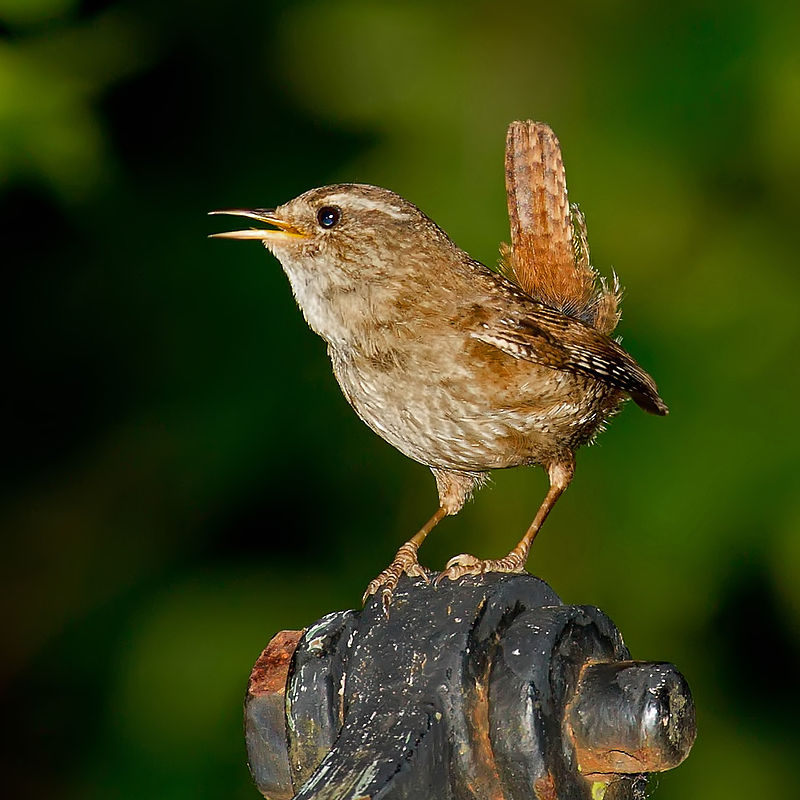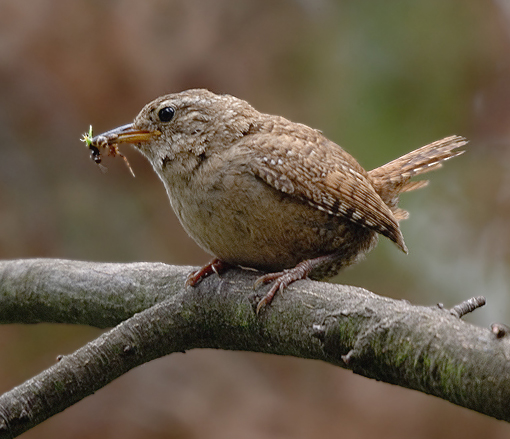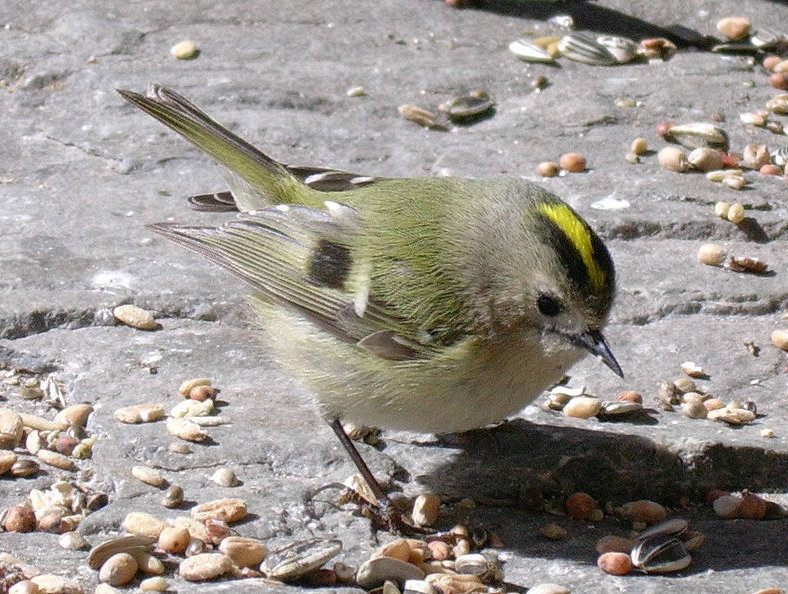Garden Wildlife
Garden Wildlife


What do they look like?
Wrens really are tiny (10cm), about 2/3 the size of a house sparrow or dunnock. They are predominantly brown at a glance, a warmish cinnamon colour. They have a more or less permanently cocked up tail, which gives them a very perky appearance. Their underside is greyish white, They have a distinct pale stripe above the eye, and their face is pale marked with streaks of blackish brown. The flanks and ventral area are barred with light brown flecks. The wing has bars on it too if you get a close look. The bill is quite long for their body, and pointed. The sexes are pretty much alike and young birds have some barring of lighter brown over the back.
If you live on Shetland or Fair Isle your wrens will be a bit bigger; these are separate races of the mainland bird, isolated on the islands and subject to different selection pressures favouring a somewhat larger size.
What do they sound like?
Wrens have one of the loudest songs of any garden bird, even though they are among the smallest in size. It is a penetrating high pitched trilling sound quite out of keeping with the skulking habits of this bird. It is often sung from quite high up in shrubs and smaller trees, in contrast to the birds’ normal ground-hugging behaviour. The alarm and contact calls of wren are also distinct. The contact call is a ‘tit tit tit’ sound.
Song Contact call Alarm call
Wren Troglodytes troglodytes (and goldcrest)
Much the smallest bird you will see regularly in the garden, although in some parts goldcrest will turn up, and that is a little smaller. Wrens are common birds, recorded in 41% of gardens throughout Britains and Ireland.
What does it eat?
As you can probably guess from the size of the bird and the shape of its bill, wrens forage for small insects, spiders and the like among leaf litter, low herbage and around structures like rough walls and flowerpots.
Where do they breed?
Wrens like to nest in small holes in walls or trees - 'caves' - hence the name Troglodytes - and build nests with a domed roof low in vegetation and also in second-hand bird nests and once in a while a nest box. They breed betweeen April and August, and have two broods each year with up to 6 eggs in each.
What do they do?
Wrens are skulking creatures but are not particularly shy of humans. They sing all year round, pretty much. Family groups are quite often seen in the late summer. Because they are small, they tend to lose heat more quickly than larger birds so need copious food to maintain their fat deposits and body temperature hence their busy nature. In winter you may see groups of wrens entering nest boxes to shelter together at night keeping warm together. In the UK wrens tend to stay put but those in Northern Europe migrate south and west for winter. In North America the wrens from northern regions migrate south and so the common name for this bird in the USA is ‘Winter Wren’.
How are they doing?
Owing to their small size, wrens are vulnerable to prolonged cold spells so their population varies a bit year on year, but overall they seem to be doing quite well with a 30% increase over the last 20 years, according to the BTO Breeding Bird Survey for 2019. There are thought to be about 80 million pairs.


Susanne Kuijpers, XC634855. Accessible at www.xeno-canto.org/634855.
Marcin Urbański, XC637079. Accessible at www.xeno-canto.org/637079.
Jacobo Ramil MIllarengo, XC638037. Accessible at www.xeno-canto.org/638037.

Goldcrest - another tiny bird
The tiny (9cm) goldcrest Regulus regulus is an uncommon garden visitor throughout Britain and Ireland, spotted in about 3% of gardens in summer. They are residents, but numbers increase greatly in winter with migrants from the north and then they are seen in up to 8% of gardens.
Goldcrest are insectivorous but take fat from feeders in winter. They like to nest in conifer woodland, but will use conifers and yew trees in gardens. Goldrest are not related to wrens, but the two are often confused because of their common tiny size.
Wren Troglodytes troglodytes (and goldcrest)
Much the smallest bird you will see regularly in the garden, although in some parts goldcrest will turn up, and that is a little smaller. Wrens are common birds, recorded in 41% of gardens throughout Britains and Ireland.


What do they look like?
Wrens really are tiny (10cm), about 2/3 the size of a house sparrow or dunnock. They are predominantly brown at a glance, a warmish cinnamon colour. They have a more or less permanently cocked up tail, which gives them a very perky appearance. Their underside is greyish white, They have a distinct pale stripe above the eye, and their face is pale marked with streaks of blackish brown. The flanks and ventral area are barred with light brown flecks. The wing has bars on it too if you get a close look. The bill is quite long for their body, and pointed. The sexes are pretty much alike and young birds have some barring of lighter brown over the back.
If you live on Shetland or Fair Isle your wrens will be a bit bigger; these are separate races of the mainland bird, isolated on the islands and subject to different selection pressures favouring a somewhat larger size.
What do they sound like?
Wrens have one of the loudest songs of any garden bird, even though they are among the smallest in size. It is a penetrating high pitched trilling sound quite out of keeping with the skulking habits of this bird. It is often sung from quite high up in shrubs and smaller trees, in contrast to the birds’ normal ground-hugging behaviour. The alarm and contact calls of wren are also distinct. The contact call is a ‘tit tit tit’ sound.
Song Contact call Alarm call
What do they eat?
As you can probably guess from the size of the bird and the shape of its bill, wrens forage for small insects, spiders and the like among leaf litter, low herbage and around structures like rough walls and flowerpots.
Where do they breed?
Wrens like to nest in small holes in walls or trees - 'caves' - hence the name Troglodytes - and build nests with a domed roof low down in vegetation and also in second-hand bird nests and once in a while a nest box. They breed betweeen April and August, and have two broods each year with up to 6 eggs in each.
What do they do?
Wrens are skulking creatures but are not particularly shy of humans. They sing all year round, pretty much. Family groups are quite often seen in the late summer. Because they are small, they tend to lose heat more quickly than larger birds so need copious food to maintain their fat deposits and body temperature hence their busy nature. In winter you may see groups of wrens entering nest boxes to shelter together at night keeping warm together. In the UK wrens tend to stay put but those in Northern Europe migrate south and west for winter. In North America the wrens from northern regions migrate south and so the common name for this bird in the USA is ‘Winter Wren’.
How are they doing?
Owing to their small size, wrens are vulnerable to prolonged cold spells so their population varies a bit year on year, but overall they seem to be doing quite well with a 30% increase over the last 20 years, according to the BTO Breeding Bird Survey for 2019. There are thought to be about 80 million pairs.

Goldcrest - another tiny bird
The tiny (9cm) goldcrest Regulus regulus is an uncommon garden visitor throughout Britain and Ireland, spotted in about 3% of gardens in summer. They are residents, but numbers increase greatly in winter with migrants from the north and then they are seen in up to 8% of gardens.
Goldcrest are insectivorous but take fat from feeders in winter. They like to nest in conifer woodland, but will use conifers and yew trees in gardens. Goldrest are not related to wrens, but the two are often confused because of their common tiny size.
Finding out more:
Page written by Roy Smith, compiled by Steve Head
What do they look like?
Wrens really are tiny (10cm), about 2/3 the size of a house sparrow or dunnock. They are predominantly brown at a glance, a warmish cinnamon colour. They have a more or less permanently cocked up tail, which gives them a very perky appearance. Their underside is greyish white, They have a distinct pale stripe above the eye, and their face is pale marked with streaks of blackish brown. The flanks and ventral area are barred with light brown flecks. The wing has bars on it too if you get a close look. The bill is quite long for their body, and pointed. The sexes are pretty much alike and young birds have some barring of lighter brown over the back.
If you live on Shetland or Fair Isle your wrens will be a bit bigger; these are separate races of the mainland bird, isolated on the islands and subject to different selection pressures favouring a somewhat larger size.
What do they sound like?
Wrens have one of the loudest songs of any garden bird, even though they are among the smallest in size. It is a penetrating high pitched trilling sound quite out of keeping with the skulking habits of this bird. It is often sung from quite high up in shrubs and smaller trees, in contrast to the birds’ normal ground-hugging behaviour. The alarm and contact calls of wren are also distinct. The contact call is a ‘tit tit tit’ sound.
Song Contact call Alarm call
























